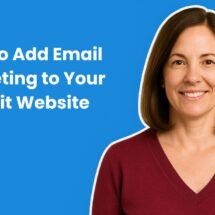Guide to Successful Email Marketing Campaigns: 7 Best Practices
By Kelly Forst September 2, 2021
Did you know people send 306 billion emails each day? That number will likely hit 361 billion by 2024. It may seem like a saturated field, but marketers report that email marketing is their leading method for acquisition and retention.
Email marketing is a powerful tool when used correctly.
But, if you don’t follow email campaign best practices, it is easy to get lost in the shuffle of emails people receive every day. Your goal should be to stand out in an inbox full of offers and provoke a response from your audience.
What is an email marketing campaign?
An email marketing campaign is a series of time-bound emails that drive a specific audience to take a desired action. Email marketing campaigns can welcome new subscribers to your list, promote an event, announce a sale, highlight a product and deliver value-packed emails to your prospects. According to a Digital Marketing Community report:
- 40% of Millennials and 33% of Gen Z prefer promotions via email over other avenues.
- 80% of Americans check their email at least once a day and 1/4 check multiple times a day.
- 62% are more likely to check emails on a smartphone and expect responsive design.
How do email marketing campaigns work?
Emails should be part of your digital marketing strategy—working with other campaigns and targeting key audiences to help you reach a desired goal. This means that your emails should be tracked and metrics gathered so you can see the impact each part of your email campaign has on your audience.
Types of email marketing campaigns
There are several types of marketing campaigns. Some brands will default to promotional campaigns, but this becomes a brand-centric approach that alienates the customer. In a solid email marketing strategy, you will use a number of different campaign types.
Welcome Email Campaigns: Your first emails introduce new customers and subscribers to your brand. Consider what impression you want to make with your welcome email campaigns (hint: don’t push sales first!).
Nurture Email Campaigns (Drip Campaigns): Tied to a lead magnet, the emails in a nurture campaign are all sent out when a lead takes you up on an offer (like a free guide or eBook). These emails should help transition the lead from their interest in the initial offer into an interest in your brand.
Promotional Email Campaigns: Emails that promote your sales, events, webinars and products are crucial for helping boost engagement, but can quickly be overdone. The right email to the right person at the right time is a killer campaign worth its weight in gold.
Customer Support Email Campaigns: Support your exisitng customers in your email marketing campaigns because customer retention is more efficient than customer acquisition. How are your campaigns supporting the leads that have already converted?
How to run a successful email marketing campaign
To get great results, you need to do more than send out random emails. Your campaign should be carefully planned out and tracked for effectiveness. Here are crucial steps to take when running an email campaign.
Identify your goals
You should never make a move without having specific goals in mind. Your marketing goals should be clearly defined so that you and your team can be on the same page. Establishing goals may seem intimidating, but they serve as a benchmark to see if you are getting the kind of traction you need from your campaigns. Always write SMART goals—Specific, Measurable, Attainable, Realistic, Timely.
Segment your audience
Your audience is filled with a wide variety of individuals at different stages in their journey with you. Treating your email marketing as a one-size-fits-all content hose is not going to benefit anyone.
When you segment your list, you can send out relevant emails to specific parts of your audience. You don’t want to send out a local event announcement for people in another country. You certainly wouldn’t want to send the same introductory emails to a loyal customer that you would send to a new lead.
You can segment your email list by things like:
- Location
- Demographic
- Age
- Gender
- Professional title
- Point in buyer’s journey
- Past purchases
- Activity on website
As you plan your campaigns, consider which audiences you will target and craft content accordingly.
Establish campaign timelines
Set the time period during which your campaign will run. Your campaigns should be a concise series of related emails, which means you need dates established for sending out emails and pulling reports.
It’s more effective to time your emails with company events, product releases, seasonal dates and content publication. Create a content calendar to help create a defined visual of when campaigns will be finalized and published.
Map your email content
Using your segmented lists and content calendar, you will visibly map your content to show who you are contacting and how content will be delivered at the right time for them. The content calendar helps align content with publishing dates, while the content map helps you identify what kinds of content you are sending out.
A content calendar for email marketing might include segments like:
- Branding (Information, Updates, Reputation)
- Promotional (Sales, Events, Webinars, Products)
- Nurturing (Drip Campaigns, Sales Funnel Emails)
- Customer Support (Tutorials, How-To’s, Guides, DIYs)
- Automated Response (Welcome Emails, Cart Reminders)
- Personalized Content (Special Deals, Recommendations)
As you map out where your scheduled emails fall, you may notice a heavy trend in one area and lacking in another. Filling the gaps can help you create a more robust email marketing strategy that covers all your bases.
Write your email content
Don’t wait until it’s time to send out an email to write the email. Create your campaign before you even send out the first email. You can always adjust the content down the road.
If the goal is to be mindful and strategic with your emails, you want to make sure they all flow together right from the start. When writing your content remember:
- Write in your brand voice, staying consistent with your other content.
- Include images and graphics in a dynamic and mobile-friendly layout.
- Trim unnecessary language to avoid wasting the reader’s time.
- Craft a subject line and opening sentence to spark interest.
- Write for the audience (not your brand) and personalize your content.
- Include a singular CTA that takes prominence and aligns with the campaign goal.
Test your emails
Don’t just start firing off emails. Test them out to address as many issues and bugs as possible. You can write out a “pre-flight checklist” to check things like:
- All links and buttons to make sure none are broken or going to the wrong place
- Image sizes (compressed to load quickly)
- Grammar and spelling
- Formatting—check the display on different devices and email clients (Yahoo, Gmail, etc.)
Testing your emails also helps ensure your content is completely ready to go by the deadline you’ve set in your content calendar. You can then schedule your emails so they are sent out during the best times for your target audience to increase your open rates and click-throughs.
Measure your campaign success
Finally, choose key metrics that will tell you if you are achieving your specific goals for the campaign or not. While you might feel nervous about defining your goals, there are things worse than failing—specifically, pushing forward without realizing your campaigns are failing. Metrics are crucial because if your campaign doesn’t work as expected, you will know to adjust for the future.
Choose the right email marketing service
Are you looking for a FREE email marketing service? Check out AWeber today and boost the success of your email marketing campaigns with access to our Smart Designer, award-winning customer service team, and more.
Are you ready to get started? Let’s talk!
 87% off ends soon!
87% off ends soon! 
